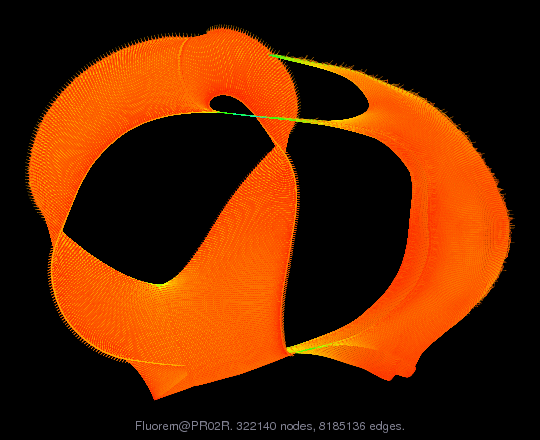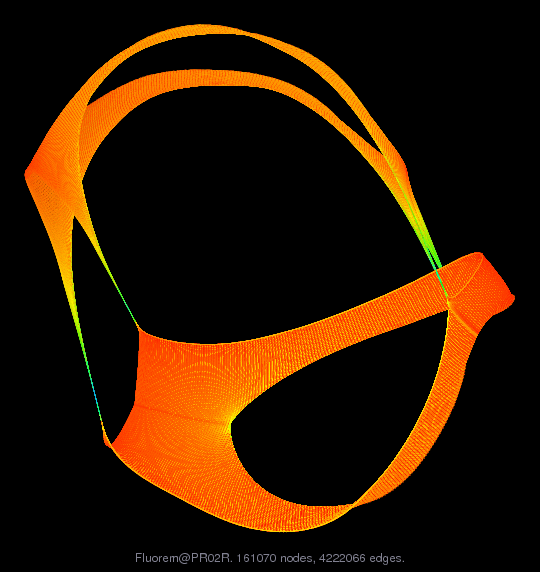

Matrix: Fluorem/PR02R
Description: PR02R: 2D turbulent case. F. Pacull, Lyon, France
 |
 |
| (bipartite graph drawing) | (graph drawing of A+A') |
 |
 |
| Matrix properties | |
| number of rows | 161,070 |
| number of columns | 161,070 |
| nonzeros | 8,185,136 |
| structural full rank? | yes |
| structural rank | 161,070 |
| # of blocks from dmperm | 457 |
| # strongly connected comp. | 457 |
| explicit zero entries | 0 |
| nonzero pattern symmetry | 95% |
| numeric value symmetry | 0% |
| type | real |
| structure | unsymmetric |
| Cholesky candidate? | no |
| positive definite? | no |
| author | F. Pacull |
| editor | T. Davis |
| date | 2010 |
| kind | computational fluid dynamics problem |
| 2D/3D problem? | yes |
| Additional fields | size and type |
| b | full 161070-by-1 |
| x | full 161070-by-1 |
Notes:
CFD matrices from Francois Pacull, FLUOREM, in Lyon, France
We are dealing with CFD and more precisely steady flow
parametrization. The equations involved are the compressible
Navier-Stokes ones (RANS). These matrices are real, square and
indefinite, they correspond to the Jacobian with respect the
conservative fluid variables of the discretized governing
equations (finite-volume discretization). Thus they have a
block structure (corresponding to the mesh nodes: the block
size is the number of variables per mesh node), they are not
symmetric (however, their blockwise structure has a high level
of symmetry) and they often show some kind of hyperbolic
behavior. They have not been scaled or reordered.
They are generated through automatic differentiation of the
flow solver around a steady state. A right hand-side is also
given for each matrix: this represents the derivative of the
equations with respect to a parameter (of operation or shape).
Since they are generated automatically, they may have "silent"
variables: these are variables corresponding to an identity
submatrix associated with a null right hand-side, for example
one of the three velocity components in a 2D case, or the
turbulent variables in a "frozen" turbulence case.
We believe that these matrices are good test cases when
studying preconditioning methods for iterative methods, such as
block incomplete factorization, or when studying domain
decomposition methods or deflation. They are actually being
studied by a few researchers in France regarding numerical
methods, through the LIBRAERO research project of the ANR (national
research agency): ANR-07-TLOG-011.
Francois Pacull, Lyon, France. fpacull at fluorem.com
Specific problem descriptions:
PR02R: 2D turbulent case
number of mesh nodes: 23010
block size: 7
variables: [rho,rho*u,rho*v,rho*w,rho*E,rho*k,rho*omega]
(rho v is "silent", the third row and column in each block
can be removed)
matrix order: 161070
nnz: 8185136
comments: This is a 2D turbulent case, dominated by
convection. The geometry is a RAE wing profile and the mesh
is C-shaped.
| Ordering statistics: | result |
| nnz(chol(P*(A+A'+s*I)*P')) with AMD | 82,852,254 |
| Cholesky flop count | 1.0e+11 |
| nnz(L+U), no partial pivoting, with AMD | 165,543,438 |
| nnz(V) for QR, upper bound nnz(L) for LU, with COLAMD | 138,682,781 |
| nnz(R) for QR, upper bound nnz(U) for LU, with COLAMD | 255,515,083 |
For a description of the statistics displayed above, click here.
Maintained by Tim Davis, last updated 12-Mar-2014.
Matrix pictures by cspy, a MATLAB function in the CSparse package.
Matrix graphs by Yifan Hu, AT&T Labs Visualization Group.